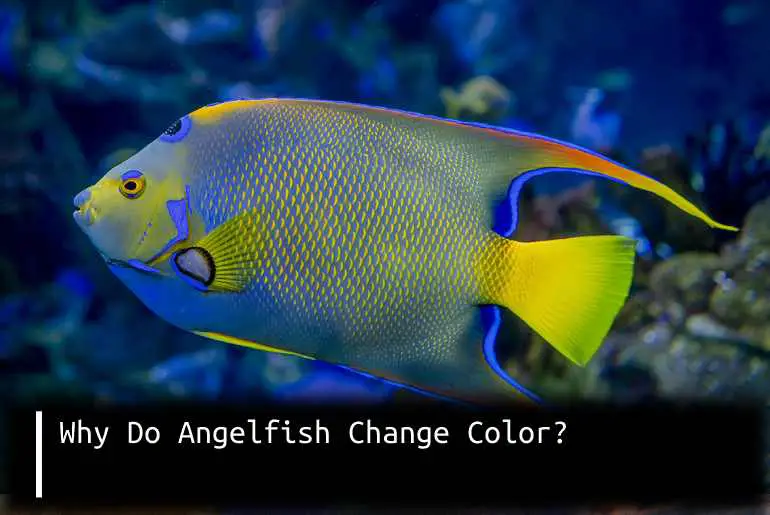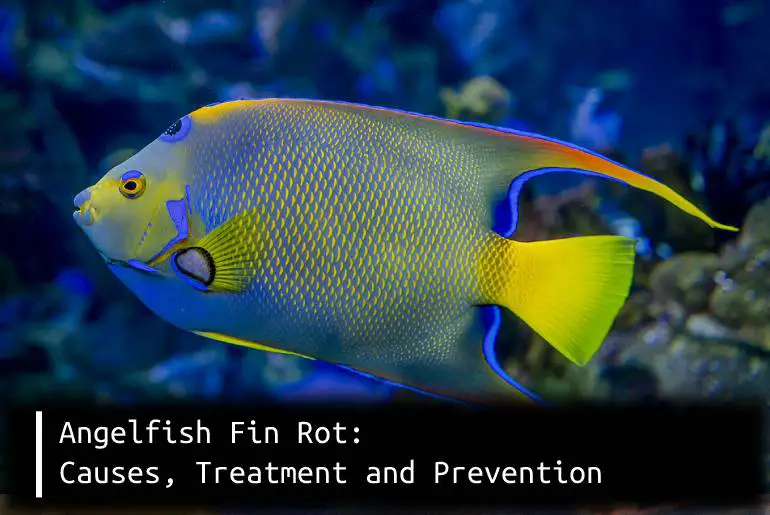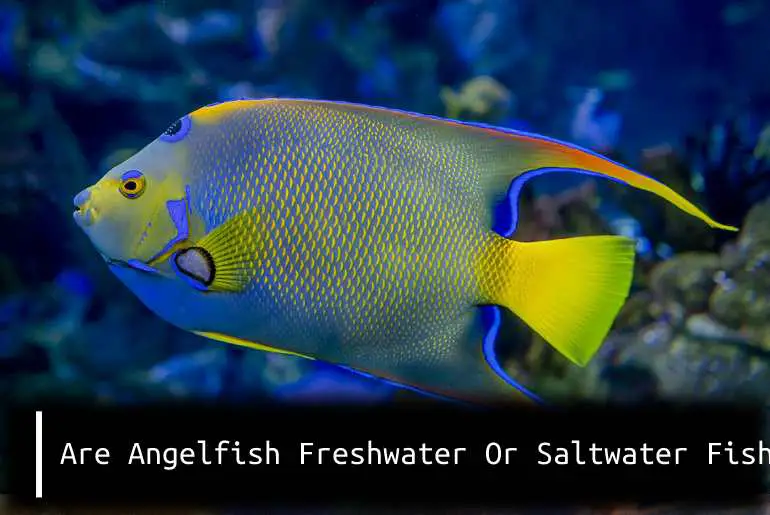No aquarist can resist the beauty of angelfish. Their wonderful color and flowing fin can win the heart of anyone. I came across a lot of aquarium enthusiasts, and everyone complimented the mesmerizing look of my angelfish. But there was one thing that often confused everyone: the color change of angelfish. Why does it occur?
Angelfish change their color a lot. Mostly, these fish change color as a natural process to camouflage and hide while resting. But sometimes your angels might change color due to serious issues like fear, stress, old age, poor water condition, and improper diet. Besides this, changes in light conditions, breeding, hierarchy establishment, and diseases can also result in the color transformation of your angelfish.
However, a sudden color change is not something to be worried about in most cases. But there are certain conditions in which color change is permanent. Today, I will discuss all these conditions in detail to understand why your angelfish are changing colors and what you can do about it.
Do Angelfish Change Color?
I had a lot of trouble answering this question when I was mature. But now that I know more about their behavior, the answer to this question would be a big YES.
Yes, definitely, angelfish change color. And while it might be a surprise for many aquarists, these fish does this very often. Usually, this is a natural defense of your angelfish to protect themselves from predators and feel safe while at rest.
So, if you notice your angelfish changing color and blending in with their surroundings, don’t be alarmed. It’s perfectly normal behavior for these fish. However, the thing to be concerned about is how these tiny creatures do such a miracle.
How Can Angelfish Change Color?
Isn’t it pretty amazing to see your angelfish changing color? But have you ever wondered how these fish do it?
Angelfish can change color by expanding or contracting chromatophores. Chromatophores are cells in the fish’s skin that contain pigment. When the chromatophores expand, they make the fish’s color darker. When they contract, the fish’s color becomes lighter.
Usually, angelfish consist of different types of chromatophores for imparting skin and eye colors. The three main chromatophore types are xanthophores (yellow), erythrophores (red), and melanophores (black).
The combination of these chromatophore types determines the final coloration of an angelfish.
Different factors like temperature, light, stress, and mood can trigger an angelfish color change. For example, a fish might become darker when it’s stressed or excited.
So, the next time you see your angelfish changing color, you’ll know how it’s doing it!
Why Do Angelfish Change Color?
Usually, the colors of an angelfish can range from very drab to quite bright, and their coloration often reflects their mood or health. A healthy fish will usually be brightly colored, while a sick or stressed fish may be duller in color.
As you know that angelfish can change color, and how do these fish do so? You would properly wonder about the situations in which these fish might do so. So, here are the reasons why your beloved angelfish might change color
To Hide or Camouflage
One of the primary reasons that your angelfish may change color is to hide or camouflage. If the fish feels threatened, it may try to blend in with its surroundings by changing its color.
For example, if an angelfish is placed in a tank with brightly colored fish, it may change its color to match the other fish in the tank. Or, if an angelfish is placed in a tank with a lot of plants and rocks, it may change its color to better blend in with its surroundings.
Due To Stress
Usually, angelfish are quite sensitive fish. Of course, most aquarists might claim these fish to be hardy. But still, any change in their environment can result in stress.
So, when your angelfish are stressed, these fish may start to change color. This is because when a fish is stressed, its body produces a hormone called cortisol. This hormone can cause the fish to change color.
Furthermore, some of the causes of stress in angelfish are:
- sudden changes in temperature
- changes in water parameters
- overcrowding
- lack of hiding places
Because Of Hunger
Your angelfish are a voracious eater. Thus, you will find these fish eating a lot. Besides this, angelfish are also omnivores that like to munch on plant and animal-based products.
Sometimes aquarists might forget to feed their angelfish. Due to the lack of nutritious food, the production of chromatophores in the fish’s body might be hindered. As a result, your angelfish may start to change color.
Usually, you will notice your angelfish becoming duller or paler in color due to the lack of food. So, if you see your angelfish changing color, make sure to check if these fish are properly fed or not.
To Attract A Mate
The beautiful color of angelfish can also help these fish to attract a mate. When an angelfish is ready to breed, it will usually become more vibrant in color. This is because the fish is trying to attract a mate.
Besides this, the color of an angelfish can also indicate its gender. For example, male angelfish are usually brighter in color than female angelfish.
When Angelfish Are Aggressive
Although your angelfish is a peaceful fish, your angels become quite aggressive when you keep them with the wrong tankmates. Usually, keeping angelfish with aggressive tankmates can bully these fish and result in stress.
As a result of this aggression, your angelfish may start to change color. The colors of the angelfish will usually become duller when your angels are bullied. This is because the fish tries to blend in with its surroundings to avoid being seen by the aggressors.
However, keeping angelfish will smaller or more peaceful fish can also result in aggression. This is because angelfish are quite territorial. So, an angry or aggressive angelfish will become darker in color to look more intimidating to its aggressor.
Due To Poor Water Quality
Poor water quality is one of the main reasons your angelfish might change color. When the water in your tank is not clean, it can cause the fish to become stressed. As a result, the fish may start changing color to indicate something is wrong.
So, if you notice that your angelfish are changing color, you should check the water quality in your tank. You can do this by testing the water’s ammonia, nitrite, and nitrate levels.
Because Of Health Issues
As mentioned, angelfish are very sensitive. So, if you fail to handle them well, your angelfish might suffer from various diseases, such as fin rot, ich, swim bladder diseases, and velvet disease.
Usually, when an angelfish is sick, it will start to change color. For example, a fish with ich may become covered in white spots. A fish with velvet disease may become duller in color.
Most commonly, health issues reduce the color intensity of your angelfish. So, if you notice that your angelfish are losing their color, it might be a sign that the fish is sick.
Sudden Change In Environment
Angelfish are very sensitive to sudden changes in their environment. So, if you make sudden changes in your tank, such as adding new plants or decorations, your angelfish might become stressed.
As a result of this stress, the fish may start to change color. The colors of the angelfish will usually become duller when the fish is stressed. This is because the fish is trying to blend in with its surroundings to avoid being seen by predators.
Due To Inappropriate Water Conditions
Your Angelfish need ideal water parameters to thrive. Generally, inappropriate water conditions disbalance the fish’s system, making them stressed. The wrong water parameters can also cause your angelfish to develop health problems.
Your angelfish cannot maintain their natural color and charm if the water conditions in your tank are not ideal. Too hot or cold water, the wrong pH, and the presence of ammonia, for example, can make your angelfish change color.
When Angelfish Get Old
Just like humans, the metabolism of Angelfish also slows down after a certain age. The production of chromatophores also decreases with age, making your angelfish lose their color intensity. In addition, older angels have higher chances of getting infections and injuries.
Generally, angelfish cannot regain their charm and color when these fish get old. All these factors can make an old angelfish change color.
I guess now you are familiar with all the reasons that can lead your angelfish to color change. As you can see, your angelfish color change is not always a thing to worry about. However, having said that, it doesn’t mean that you should stop worrying when your pet change color.
So, when can color change in angelfish be a serious issue?
Is Color Change In Angelfish Serious?
Usually, your beloved pet changes color for various reasons, and the color change might not be a dangerous indication in most cases. There are many cases where the owners neglected their angelfish and the color change symptom; this later cost them their fish.
Surely, you would never want to repeat the same mistake, do you? So, to help you out and separate when the color change in angelfish might be serious, I have few signs that you must look at.
- Flared or clamped fins
- sudden weight loss
- lethargy and immobility
- loss of appetite
- sudden aggression toward tankmates
- lying at the bottom of the tank
- excessive hiding
- constantly bumping in objects or other fish
- gasping for air at the surface of the water
These are primary symptoms that show something is definitely wrong with your angelfish. If you notice any of these, it would be best to take them out and examine them more closely. After that, you need to take action immediately.
How To Stop Angelfish From Changing Color?
Since color change is a natural angelfish behavior, it is impossible to stop it. And to a certain extent, the color change is also a sign of well-being and vitality of angelfish. However, the problem appears when the color change becomes excessive or the fish changes color too frequently.
Thus, to solve these issues, I have a few tried and tested techniques:
Keep Angelfish In A Stable Environment
The first and foremost thing you need to do is to provide a stable environment for your angelfish. Usually, this includes keeping an angelfish tank in a peaceful environment, using low-intensity lights, and avoiding too many fish in your tank.
Give Angelfish Nutritious Meal
A well-balanced and nutritious diet is also very important for the health of your angelfish. Make sure to feed them high-quality food that contains all the necessary nutrients and vitamins.
You can also try using color-enhancing foods to help your angelfish maintain their color. Some good examples include spirulina, krill, and Mysis shrimp.
Remove Stressors
As mentioned, angelfish are easily affected by stress. Thus, you need to find out the stressor and remove it from the tank. Some common stressors include poor water quality, diseases, wrong water parameters, and aggressive tank mates.
Once you have removed the stressors, you should significantly improve your angelfish color.
Introduce More Hiding Places
Since angelfish love to explore the surroundings and move all around the tank, these fish also require some place to be safe and secure. That’s why you need to provide them with plenty of hiding places, such as caves, plants, and driftwood. This way, your angelfish will feel more comfortable in the tank, and their color will also improve.
In addition, the live plants in the tank can also help to increase oxygen levels and enhance the coloration of your angels.
Monitor Water Parameters
It is also very important to monitor the water parameters in your tank. This includes temperature, pH, ammonia, and nitrite levels.
Make sure to keep these levels within the optimal range for angelfish. i.e., the temperature of 75-82 degrees Fahrenheit, pH of between six and eight, ammonia and nitrite levels at zero. Since this will provide a healthier home for your angelfish and help prevent color loss.
By following these tips, you should be able to stop your angelfish from changing color excessively and also help them maintain their vibrant colors.
Do A Water Change
Lastly, don’t forget to do a water change regularly. This will help to keep the water quality in your tank at its best and also help to remove any toxins that might be present in the water.
I would suggest changing around 20-30% of the water weekly. Usually, changing water and installing filters, air pumps, and other equipment has done wonders for me. You should try it too.
Following these tips, you can easily stop your angelfish from changing color excessively and help them maintain their vibrant colors.
Does Color Change In Angelfish Indicate Something?
You will be surprised to know that your angelfish change to different color according to the conditions. So, if you are thinking that your angelfish is changing color because it is not healthy, then you are wrong. Each color in angelfish holds a different meaning.
Moreover, here are some color changes and their meanings:
Angelfish Turning To Brown Color
Brown color change in angelfish is a natural process. It happens when your angelfish is getting old or when light intensity fluctuations occur. But if the brown is too dark, velvet disease is a sign.
Angelfish Turning To Pale Or White
The water conditions are not good if your angelfish has turned pale yellow or white. The water might be too cold or too hot for your angelfish. Also, the ammonia and nitrite levels in the water might be high, and there is not enough oxygen in the tank.
Besides this, fungal and bacterial infections also cause your angelfish to turn pale yellow or white.
Angelfish Turning To Gray Or Black
It is a sign of happiness and comfort if your angelfish has turned to gray or black color. Also, it is the color of spawning. Furthermore, your angelfish might also turn black when these fish are in new environments.
Angelfish Turning To Yellow
Usually, your angelfish turn yellow when these fish are ready to mate or when the water conditions are not good. Moreover, the yellow color signifies poor water quality, overcrowding, and toxins in the water.
Angelfish Turning To Orange
Your angelfish turns orange when it is happy and healthy. Also, this color change happens during spawning. However, if their fins display pale orange spots, it indicates that their tank does not have ideal water and these fish are suffering from fin rot.
Angelfish Turning To Red
The presence of carotenoids in the diet of your angelfish causes these fish to turn red. Besides this, redness in angelfish is also a sign of ammonia poisoning and high nitrite levels. Similarly, your little guys might also turn red when there is too frequent water change or when these fish are under stress.
Angelfish Turning To Green
Green color change in angelfish is a very serious issue. Usually, your angels turn green during health issues, improper water conditions, and when these fish are not getting a good diet. Also, the green color might indicate the presence of parasites in your angelfish.
As you can see, there are various reasons your angelfish change color. So, next time you see your angelfish changing color, do not panic. Just know the cause and solve the problem.
The Bottom Line
To sum it up, the color change in angelfish occurs due to various reasons such as old age, water conditions, spawning, and diet. Also, each color change signifies a different meaning. Therefore, you should know the cause before taking any action.
I hope this article has helped you to understand why your angelfish change color. If you have any questions, please feel free to ask in the comment section below.
Thanks for reading!






